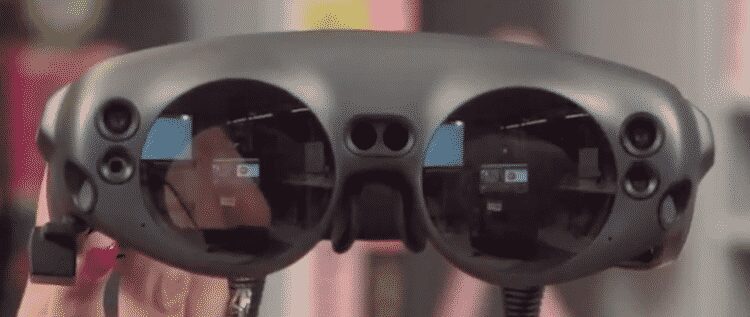Yesterday, Magic Leap offered a “Meet Magic Leap One” demo of their forthcoming headset. Problem is, they weren’t very forthcoming at all. At best, the Magic Leap Mixed Reality headset remains a work in progress.
Outside of the lucky ones who have gone to Florida, signed an NDA and tried it (and yes, they rave about it), the rest of us were left with a “show and tell” that didn’t answer even basic questions about the device. We’ve been following Magic Leap since the beginning – we first wrote about them back in 2015 (actually had to go back and check the date) – and after all that time, we’re still woefully short on details.
What’s so curious about yesterday’s live-stream is that crowd on Twitch was heavily oriented toward developers – that’s not a group you want to upset. They don’t need tips such as “you need to think outside the box” while the demo unit sits there lifeless on a table (they did eventually turn it on). It sounded like something you’d say to Middle School students – and even they would figure that out before you said it.
Road to VR summed up the feelings of many,
Since the beginning, Magic Leap has been a masterful tease. Between more than $2 billion in venture funding, evocative descriptions of “magical” technology, behind-closed-doors demos, and celebrity endorsements, Magic Leap has captured the curiosity of many, promising no less than to change the world as we know it. But, at least for many of the company’s closest followers, the hype high seems to be turning into a disappointment hangover.
In fact, at some points during the “demo” the comments in the chat stream were far more interesting than what Magic Leap was (not) showing us. The disappointment hangover continues.
Magic Leap Mixed Reality headset

So here’s what we learned about the new headset besides the obvious features such as adjustable size, audio jack, and wi-fi that any decent tech device is going to offer:
- The Magic Leap One isn’t designed for outdoor use.
- The headset has a LED indicator on the front to let people know if you are recording video or snapping photos. . .
- Eye-tracking was mentioned once again, as well as talk of a calibration process during headset setup.
- The little box hanging off the right side of the headset was described as an “antenna” for tracking the controller (potentially indicated magnetic controller tracking).
- The controller has LEDs on the trackpad which can be used to indicate to the user different contextual input areas. There’s also haptics in the controller. . .
- Magic Leap is working with a partner to eventually offer a prescription lens add-on for those with glasses; the headset itself isn’t designed to accommodate glasses.
- The compute unit is designed to clip onto a pocket, with part of it exposed for cooling purposes; a belt will be included for times when the user may not have a pocket available. . .
- ‘Magic Leap World’ is the company’s app store platform
- The headset will support voice commands.
- The company is working on a stand for the device.
All of the questions that developers wanted answers to – weight, price, battery life, FOV – were ignored or curiously seen as “trick questions”. After years of watching live demos of new products from Apple, Microsoft, and even Intel’s now-shelved Project Alloy, you wonder why the secrecy. Is it not ready? Is the FOV worse than HoloLens? The display too dim?
We wish we knew what their strategy is.
But if you missed the event and want to view the entire demo, it’s on YouTube. Here’s the shorter 10-minute version which covers just the actual demo of the Magic Leap Mixed Reality headset.
The Promise of Mixed Reality
Thinking about the Magic Leap device reminds me of my first iPod. We all knew Apple was working on something. We all mostly knew what it would do as there were several portable music players already on the market. Yet we were counting the days to its release. We proudly carried the iPad with its spinning wheel of 999 songs. I loved mine, but most of us had no idea that in a few years there will be iPod Nano and then one day the iPod will simply disappear and embed itself in our phones and watches.
So this is where we are now with Magic Leap. It’s going to be fun to play with, but it’s the devices that will come after the first release that makes the real impact. One day, maybe in 2023-2025, it will morph into something that will become part of our everyday lives.
Besides the little we actually know about Magic Leap, the more important point is that we know very little about Mixed Reality. Most of the insights come from our traditional understanding of media – or early groundbreaking devices like Google Glass, Microsoft Hololens and other AR projects. These are all projects that have made an impact on development, design, and interface issues but we are far from understanding Mixed Reality itself or how it will evolve.
Mixed Reality is about breaking the boundaries between the physical and virtual world. It is as much about engineering the next version of the device as is about the evolution of our understanding of the interplay and interaction of the physical and the digital world. How do we design for a world when it – and we – will likely exist in multiple forms and locations? A world that will be enveloped in layers of digital information? This is what we need to discover.
A curated, walled garden experience, presents a great space to play but it only opens the door to mixed reality and doesn’t define it. We need better glasses, an open ecosystem, affordable price, 5G and beyond to move into the age of spatial computing. Yes, we can’t wait to try the Magic Leap Mixed Reality headset later this year and we hope the widespread anticipation translates into enthusiasm for building a diverse ecosystem around it. At the same time, we feel like this could be an overpriced toy that will have its 5 minutes of fame before the next one arrives.
Magic Leap, it’s time to show us what you have.
Maya Georgieva is an EdTech and XR strategist, futurist and speaker with more than 15 years of experience in higher education and global education policy. Her most recent work focuses on innovation, VR/AR and Immersive storytelling, design and digital strategy. Maya actively writes and speaks on the topics of innovation, immersive storytelling and the future of education and consults organizations and startups in this space.

